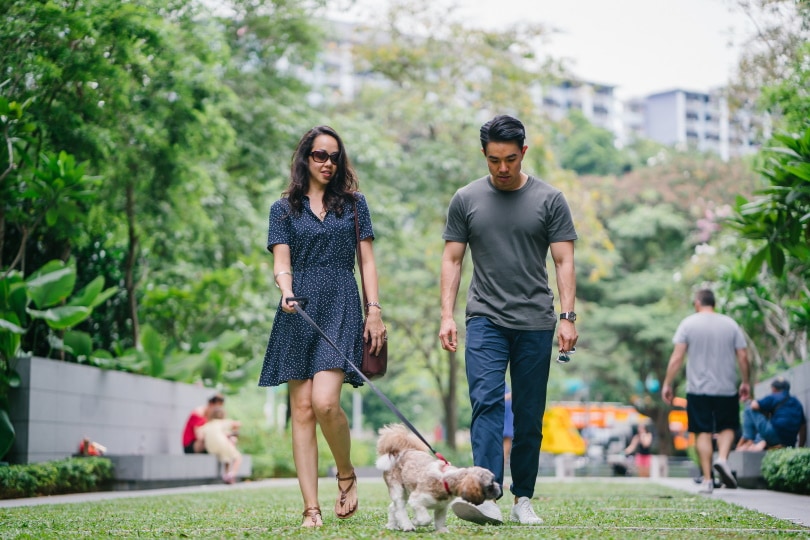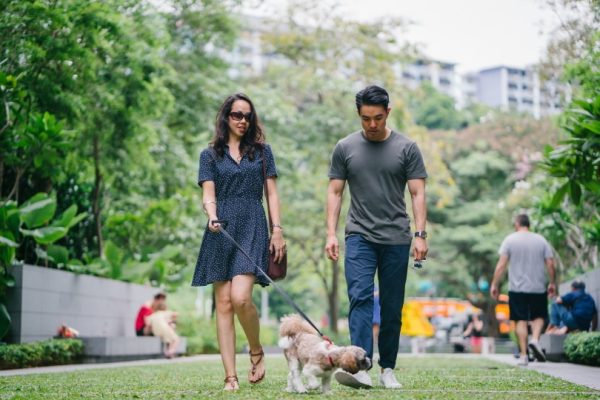Every responsible dog parent wants to make sure their dog is well-equipped to handle going out in public and interacting with other people and dogs. For this reason, most people start training their dogs as early in life as possible.
Well-socialized dogs are calm and collected in public places, but not every dog has the luxury of being trained from a young age by caring, responsible owners. In some cases, rescue dogs suffer from stress and anxiety when out walking or interacting with other dogs as a result of trauma, abuse, or neglect in the past. Stressed dogs can pull on the leash, bark at other dogs or passersby, or even refuse to walk at all.
In this post, we’ll share some tips on training your dog to be calm in public and how to soothe dogs that get anxious when out walking.
The 10 Tips on How to Train Your Dog To Be Calm in Public
1. Pick a Quiet Time
When just starting out, it’s not the best idea to take your dog out when they’re all hyped up or to a place where there’ll be a lot of people or other dogs—especially if your dog is the nervous type.
Wait until your dog is in a relaxed mood and has been to the bathroom before walking them. Start out nice and slowly and visit nearby, calm places. This way, you also have the peace of mind that home isn’t far away if your dog starts to stress out.

2. Walk in Short Bursts
If your dog is showing signs of anxiety when outside, you might want to try starting out with short walks and gradually building up to longer ones as they become more confident.
You could try breaking up one long walk into a few shorter walks throughout the day, each lasting around 10–15 minutes at a time or however long works for you. This makes the whole thing less intimidating for both you and your dog. Allow your dog to control where you walk and let them sniff as much as they want—this is comforting to them and gives them a sense of control.
Likewise, if you’re going to an indoor area like a dog-friendly café, take your dog only for short periods at first. For example, this could mean popping in and grabbing a takeaway coffee. This way, you can gauge whether or not your dog is ready to stay for a longer time.
If you do take them to sit inside, avoid staying for too long at first and sit in a quiet area of the café so your dog won’t get overstimulated.
3. At-Home Training
You can start training your dog to be calm out in public from your home. As bizarre as it may sound, put your dog’s leash on in the house and sit next to their bed or a blanket. If your dog settles down on the bed or sits calmly and quietly without tugging at the leash, barking, or trying to get your attention, silently give them a little treat as a reward.
This helps them to associate relaxed behavior and positive reinforcement with their leash. For some dogs, it may take longer for them to get the hang of it, but once they do, this is a great foundation to build on when out on walks.
When they’ve gotten the basics down, start leaving it longer before you reward them. For example, if you’re rewarding them for settling down, have your dog be settled for a few extra seconds before giving them the treat, increasing the number of seconds each time you do a “session”. This shows them that being relaxed for longer intervals gets them a reward.

4. Reward Good Behavior Outside
When walking with your dog, reward good or relaxed behavior like not pulling at the leash or barking at other dogs or people with a treat, just like you do at home. If your dog isn’t really food-motivated, you can try giving them their favorite toy to carry instead or simply distracting them with it.
Sometimes, even giving your dog something to sniff is enough to distract them. Don’t forget to heap on the praise, too. Remember to keep your dog close by your side when you’re leash-training them.
5. Socialize Your Dog
Whether your dog is an adult rescue dog or a puppy, socializing them to be around other dogs and people is crucial. If friends and family members have well-socialized, friendly dogs, this is perfect. If you’re worried about how your dog will react to other dogs, keep them on the leash for the first meetings and keep the dogs at a distance from each other.
Be sure to introduce your dog to nice new people, too. The more they get used to other people and dogs, the more confident they will feel out in public.
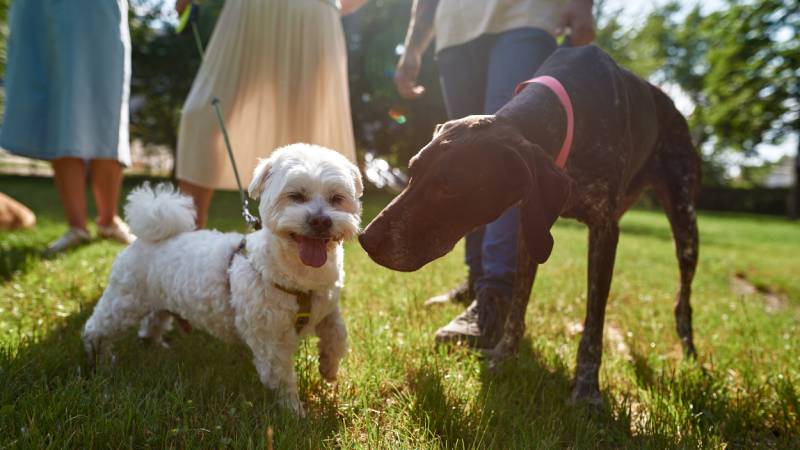
6. Teach the Basics
Dog training starts at home. Familiarize your dog with basic commands such as “sit”, “stay”, and “come”. If your dog knows and can follow these commands, it will give you more control when out in public with your dog.
7. Exercise Your Dog Regularly
A dog that is exercised regularly is more likely to be calmer in public as it helps them get rid of any pent-up energy. Dogs that don’t get enough exercise are often bored, hyped-up, and very frustrated. Play with your dog daily by throwing the ball, playing with chew toys, or doing whatever exercises you and your dog enjoy.
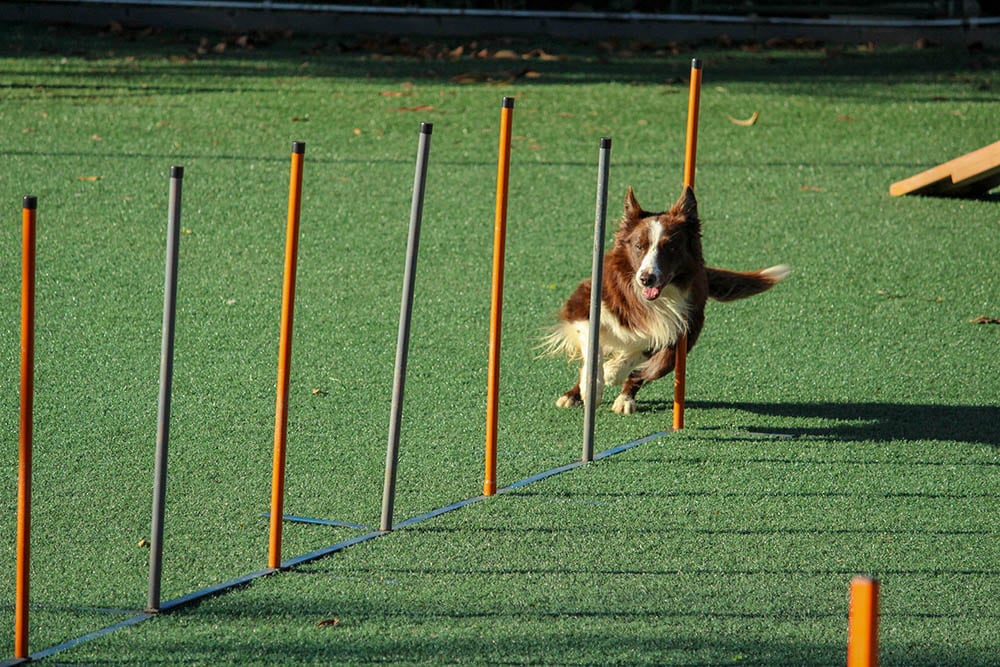
8. Act Silly
This next one may sound a little weird but hear us out. This technique is called the “jolly routine”, and it’s often used to help nervous or anxious dogs not feel tense or frightened in public. For example, if one of your dog’s triggers is other dogs, wait until you see another dog approaching while you’re out walking.
Relax your body (this helps your dog relax), talk to your dog in a “baby voice”, smile, laugh, and keep your body language open and friendly. This shows your dog that there’s nothing to be afraid of. You may feel like a bit of a buffoon doing this in public, but hey, it can work!
9. Go to Obedience Classes
If you’re having a hard time getting your dog to lighten up when out in public, it might be worth giving obedience classes a shot. These are run by people who know the best methods for keeping dogs as calm and relaxed as possible and the sessions give your dog a chance to be around other dogs in a non-threatening, controlled environment.
If you’re worried about your dog acting out, remember that dog obedience trainers have seen it all before and will be able to teach you some invaluable techniques.
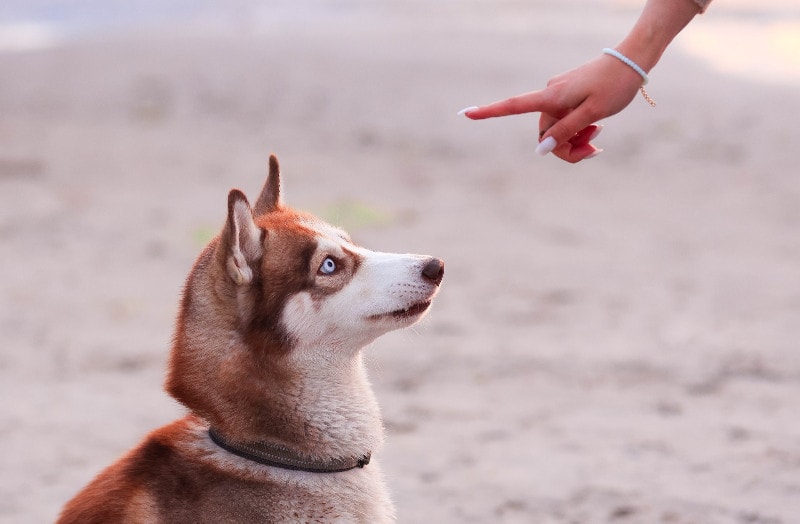
10. Stay Positive
We know how distressing it can be when your dog acts out in public—believe us, we’ve been there! As hard as it is, our final piece of advice is to stay as calm and positive as you possibly can. As mentioned above, your dog can sense when you’re all tensed up with stress, which makes them feel as if there’s something to be stressed about.
Never punish your dog for their little displays out in public—this just won’t work. Always be consistent, set a routine, use positive reinforcement, distract your dog if they start to get stressed, and keep your body language as relaxed as possible. With time, this should (hopefully) teach your dog that being out in public is an enjoyable activity, not a stressful one.
Conclusion
If you’ve been struggling to keep your dog calm in public, just remember that you’re not the first and you certainly won’t be the last. Every dog is an individual and, while some are naturally pretty chilled-out and take to being out in public like a fish to water, it takes more time with some dogs—especially those that have experienced trauma in a past life.
Patience, positivity, and consistency are key when it comes to training your dog to be calm in public. If you’re concerned that your dog may be suffering from canine anxiety or other behavioral issues, please consult your vet for advice.
Featured Image Credit: Piqsels

